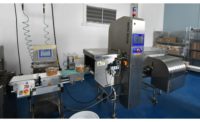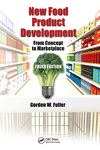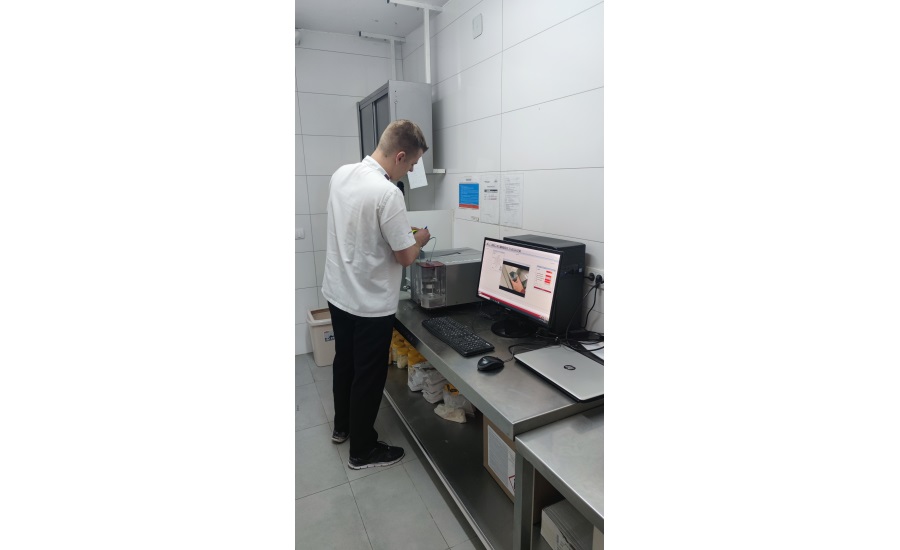By: Lena Bosc-Bierne, Product & Applications Specialist for KPM Analytics’ CHOPIN Technologies product brand
 Time is our most valuable asset. Bakers balance many responsibilities while running their operations, so finding any spare moment to slow down, take a step back, and consider whether they can improve their methods for conducting daily tasks, is not something that comes along very often. But when an opportunity presents itself to help you take back your time, not only can it improve the efficiency of your operation, but it can also become a catalyst to positively influence others throughout your organization and the entire baking community.
Time is our most valuable asset. Bakers balance many responsibilities while running their operations, so finding any spare moment to slow down, take a step back, and consider whether they can improve their methods for conducting daily tasks, is not something that comes along very often. But when an opportunity presents itself to help you take back your time, not only can it improve the efficiency of your operation, but it can also become a catalyst to positively influence others throughout your organization and the entire baking community.
For the R&D team at Puratos Serbia—a division within the global Puratos family of business units serving the bakery and patisserie producers—time is always at a premium. The team is responsible for developing powdered products used in baking and oversees the development and quality control for Puratos’ extensive line of semi-finished baked product mixes. The Puratos company produces hundreds of pre-mixed baked product recipes, including pan bread, buns, rolls, and patisserie products.
Many food-producing companies, from industrial producers, large restaurant chains to cafes, rely on mixes from Puratos Serbia so they can provide a variety of freshly baked products to their customers on a daily basis. Each mix is distributed with all ingredients in exact ratios to produce a particular baked product easily and efficiently.
“As a producer of high-quality product mixes, we need to have a full view of everything that is actually going into our products,” says Ivana Aničić, R&D manager for Puratos Serbia. "Our customers simply take our mixes, pour water, add yeast, and begin their baking process. It is up to us to ensure that our products meet their consumer’s expectations with each mix we distribute.”
Because they are the main line of defense for products design and quality, Puratos Serbia spends significant time conducting baking trials on their products, in their Innovation Center and QC lab. In the past, with each new flour batch, the team would run several baking trials on a specific product, tweaking their recipes as needed, before finding a ratio of flour and ingredients that was on-brand for product expectations. Each additional round of testing leads to more time lost and spent ingredients, impacting the company's bottom line.
What makes a good baked protein mix?
Like any baked product recipe, developing a product mix is a trial and error process to find the right balance of ingredients, enzymes, improvers, and other recipe components. However, even if all other variables are controlled to the finest detail, one element in a baked product mix can offset the entire process: flour quality.
For practical reasons, due to rising wheat prices, millers are more likely to make their raw wheat purchase from their suppliers based on cost rather than quality. However, this produces a trickle-down effect where final product quality can suffer and reflect poorly on a baking operation.
Flour quality is typically measured based on the availability of a few standard quality parameters. Protein content has traditionally been a priority for baking operations, but amylase activity, and dough rheology (water absorption and dough behavior), among others, also factor into flour quality.
Determining whether a flour batch is "good" or "bad" is not always a straightforward answer. Certain types of flour are better suited to produce one kind of product over another (e.g., the flour used for pizza dough may not offer the same properties to make crackers). Also, regional tastes or expectations for a specific baked product may factor into the flour selection (e.g., a baguette produced in France may have a different texture or crust than one made in China).
Another variable is the availability of high-quality flour within a specific region. Many regions import their flour from parts of the world that may not have access to advanced wheat harvesting or flour milling equipment and storage, which also presents additional challenges when assessing this vital ingredient.
To truly understand how a batch of flour will adapt to a particular product, bakers are left with few options other than putting the flour through the baking process, analyzing results, and adjusting as needed.
Discovery of a new method to interpret baking trial results
While baking trials provide the outcome of the production process, they can sometimes prompt more questions than answers. Rarely is there clear reasoning as to how or why the results occurred the way they did from one trial to the next, leading the baker to rely on subjective interpretation.
In 2020—at the height of the COVID-19 pandemic—the R&D team at Puratos Serbia used the lockdown to return to their roots, reintroducing themselves to the science of baking. With so much product variation that would often occur during their trials, the team began researching new methods to help reduce the subjectivity in their R&D and quality assurance programs for their product mixes.
Through these efforts, they discovered the CHOPIN Technologies Mixolab 2: a universal dough characterization tool bakers use to simulate their baking process in a fraction of the time and ingredients involved with baking trials. As an all-in-one instrument, Mixolab 2 collects information on flour or mixes' water absorption, mixing behavior, gluten resistance to heating, viscosity, amylase activity, and other processes to present the results in a data curve.
“We started our journey with this dough characterizer as a pioneer within the Puratos group,” says Aničić. "We would typically send the flour samples to an external lab to make rheological analyses, adding more steps to our quality control protocol. We realized to bring this analysis in-house, we could help improve our operations in many ways.”
The Puratos Serbia team first began by analyzing incoming flour to gain a preliminary understanding of what is happening during the baking process. The team then began introducing functional ingredients to the process, including enzymes, emulsifiers, and others, to see how those variables could influence their data curve.
As R&D team member Nemanja Mandic recalled, these preliminary trials led to a breakthrough moment for him and Puratos Serbia. "We began to perform trials in parallel with our baking trials, using the same ingredients in the mix and water content ratios. From there, we realized that we could match our baking trial result with the output from the instrument, which would help us apply quantifiable data to determine whether any variations could have affected final product results.”
“When you match product result with the curve from the instrument, you have a benchmark for what the 'ideal' product should look like. This is information we never had access to before," says Mandic.
The product database building begins
One-by-one, the Puratos Serbia team began building “profiles” for the company’s many product mixes. As Aničić states, the database building project has been a lot of work, but Puratos Serbia has realized paybacks for their efforts in many different ways.
"We have run thousands of analyses, spending a lot of time trying to crosslink our baking trial results with our dough characterizer," says Aničić. “But this process has allowed us to obtain a baseline expectation for how a particular flour will impact the quality of a specific product. Now, we have a much clearer idea of flour quality and make corrective adjustments to our mix recipes before we even begin a baking trial. This process has proven to be repeatable and saved our operations costs in both R&D and quality control efforts."
Armed with a "dough interpreter," Puratos Serbia shares experiences and insights
Puratos Serbia team's efforts have not gone unnoticed by their parent company. After sharing their successes, the team began collaborating with others in the organization to help solve quality control challenges they frequently encounter.
Assessing causes of wholemeal wheat flour quality variations
In this experiment, Puratos Serbia tested 15 different flour samples from their local mill in order to try and determine how there could be such significant variations in their final products. These flour samples were collected from different harvests at different points, from May 2020 until March 2021.
After running each flour sample through their flour profiling process, the team noticed that the flour's gelatinization, amylase activity, and retrogradation readings (relating to product shelf life) displayed significant variations from one sample to the next. "For us, it's a big problem if you have viscosity and amylase index variations. It can lead to poor structure, poor fermentation, and other issues, so this was very useful for our team to see," says Mandic.
Most importantly, this exercise demonstrated how important it is to make flour quality analysis an essential part of a quality control regimen. "With this data, we have a better idea of what to expect from our flour quality, not just from different regions of the world, but from different harvests throughout the year,” says Aničić. “In fact, we can use these flour quality benchmarks to effectively see when our miller is switching their product from one harvest to the next. The dough characterizer helps us see whether our flour is behaving oddly, then correct our mix to compensate the product, or send our delivery back to the supplier.”
Enhancing data from texture analysis
The texture is a crucial measure of quality for many baked products. As an additional step in their quality assurance program, Puratos Serbia uses a Texture Analyzer to quantify the textural characteristics of their products after baking trials.
With each flour test, that same data can also align with the results from their Texture Analyzer.
"When we have a project relating to analyzing freshness from products like toast or buns, we perform parallel tests with our dough characterizer, then align the Texture Analyzer results from the products produced from our baking trials," says Aničić. "This gives us objective results relating to the finished product characteristics, including mouth feel, resilience, short bite, and others, and we combine those results into our protocol."
Improving communication with suppliers and customers
Quality assurance is also at the forefront in all of Puratos Serbia’s business transactions—whether purchasing flour from their miller or working with a customer to solve a specific challenge.
Recently, Puratos Serbia has begun using their dough characterizer as a flour quality verification tool with one of its millers. This miller, who owns the same instrument, submits their flour delivery along with a datasheet of readings from the dough characterizer. The Puratos Serbia team will still conduct their trials on the new flour to ensure their results are comparable with their miller. This process has significantly reduced any of their flour delivery rejections from this supplier, says Aničić.
"When we communicate with our customers that we own Mixolab 2 as our tool, we usually present it as something that gives us full insight on raw materials and our final products. It gives our brand security that our customers trust while allowing us to develop customized product solutions to serve their consumer's demands," says Aničić.
Leading the way to improve quality control methods within Puratos
Puratos Serbia continues to lead many company-wide quality assurance efforts within the Puratos organization. While still in the process of developing product profiles for each of the company's vast and growing product line, the team is also leading educational efforts within the company, all to improve quality through every step of their process.
"Before any of these efforts, it was like a fog when assessing flour quality for a particular baking mix," says Aničić. “Now we have much clearer methods that have helped us reduce baking trials and focus our efforts to help our colleagues and customers solve their challenges relating to flour or dough quality analysis.”
About the author
Lena Bosc-Bierne has an Engineering Degree in Food Science specialized in grain industry from the French Engineering school Polytech Sorbonne (Paris, France). She works for CHOPIN Technologies—part of KPM Analytics—since 2014. Her role of products and applications specialist consists in working with people all around the world. She provides personalized solutions to customers willing to improve control of their products and processes. Her responsibilities at CHOPIN include the management of several products from the idea conception to the market launch, the standardization of the solution, and the final use.


















